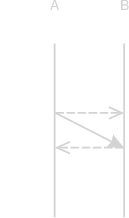Ecosyste.ms: Awesome
An open API service indexing awesome lists of open source software.
https://github.com/hildjj/quence
Create sequence diagrams from textual descriptions.
https://github.com/hildjj/quence
Last synced: 19 days ago
JSON representation
Create sequence diagrams from textual descriptions.
- Host: GitHub
- URL: https://github.com/hildjj/quence
- Owner: hildjj
- License: bsd-2-clause
- Created: 2013-04-25T20:16:12.000Z (over 11 years ago)
- Default Branch: main
- Last Pushed: 2024-05-21T20:19:58.000Z (6 months ago)
- Last Synced: 2024-10-18T20:35:16.893Z (28 days ago)
- Language: JavaScript
- Size: 7.72 MB
- Stars: 24
- Watchers: 5
- Forks: 9
- Open Issues: 2
-
Metadata Files:
- Readme: README.md
- Changelog: CHANGELOG.md
- Funding: .github/FUNDING.yml
- License: LICENSE
- Authors: AUTHORS
Awesome Lists containing this project
README
Create sequence diagrams with a domain-specific language.
```text
Usage: quence [options]
Arguments:
FILE file names to process, "-" for stdin
Options:
-o, --output output type (choices: "js", "json", "pdf", "svg",
default: "pdf")
-O, --out output file name, "-" for stdout. Not valid with
more than one input file.
-p, --property diagram property in the form key=value. May be
specified multiple times. (default: [])
-v, --verbose verbose logging
-V, --version output the version number
-h, --help display help for command
```

Small example:
```
set text_color purple
Alice -> Bob: Hello #comment
Bob -> Alice: World
Bob -> Bob: !
```
Try it online
=============
There is a client [editor](https://hildjj.github.io/quence/).
Installation
============
Use [npm](http://npmjs.org/):
```
npm install -g quence
```
Syntax
======
The following sections describe syntax that can be placed in a `.wsd` file for
input to the quence processor.
Comments
--------
`# [comment]` Place a comment on a line by itself, or at the end of any line.
If you need a `#` in a string, enclose the string in double quotes (`"`).
`participant "[description]" as [name]` Create a new participant in the order
that the `participant` directive appears in the input file. The `description`
is output, and the `name` is what is used for reference in later directives.

Example:
```
participant Alice
participant "Bob Cat" as bob
```
Arrows are draw between participants with open ends, closed ends, solid or
dashed lines, and may be bi-directional.
### ends
`<` or `>` closed arrow end
`<<` or `>>` open arrow end
You can also use the `#` indicator to show that a packet is lost.
This will create an "X" arrowhead and only draw the line halfway
across.
### lines
`-` solid line
`--` dashed line
Example:

```
# A "normal" message from A to B
A -> B
# An "exciting" message between A and B
# No, this doesn't have any defined meaning, as far as I know
A<-->>B
```
Messages
--------
The minimum message looks like `participant arrow participant`, but a full description is:
```
[label:] participant[@time] arrow participant[@time] [:title] [[message properties]]
```
Draw a line with
[arrows](#arrows) between two [participants](#participants). A participant
that has not been previously mentioned will be automatically created. Note
that a message may be of the form `B -> B`, which produces a self message.
### Title

A message can have a title that will be drawn over the message line. The title
will be justified toward the start of the message, or in the middle for
bi-directional messages.
Example:
```
A->B: The title
```

### Timestamps
Each message start time can have a timestamp associated with it by prefixing
the message with `label:`. Subsequent messages can be declared to start or end
at a given label by suffixing the participant name with `@time`, where `time` is
the label from a previous message.
This will usually result in a diagonal line.
Example:
```
early: A-->>B
late: B-->>A
A@early->B@late
```
## Notes
You can put a note on an endpoint using `note`, as in:
```
note A: This is a note
```
## Blocks
You can create a dotted block boundary around a section using the `block`,
`loop`, and `opt` commands, as in:
```
block Do a thing
A->B: Some messages
end
loop Many times
A->B: Some messages
end
opt Might happen
A->B: Some messages
end
```
The difference between these commands is that `loop` and `opt` also
produce a shaded tab with the words "loop" and "opt" respectively,
whereas `block` just labels the block but with no shaded tab.
### Message properties

Message properties modify the message, and are of the form `name [= value]`,
with multiple properties separated by a comma (`,`). The following message
properties may be set:
* `duration`: The number of time slices that this message takes up. If this is
not `1`, a diagonal line will result. [Default: `1`]
* `advance`: The number of time slices to advance the clock after this message.
This is useful after a flurry of crossing diagonal lines. [Default: `1`]
Example:
```
A->B [duration=2, advance=2]
B->A [duration=2]
```
## Diagram Properties
`set [property] [value]` set a property governing the production of the
diagram to the given value. If the value is omitted, it defaults to `true`.
Colors can be [named colors](https://www.w3.org/TR/css-color-4/#named-colors)
or specified in hex, surrounded by quotes, like `'#f0f8ff'`.
You can also set an option with the `-p` a command line flag, as in:
`-p property[=value]`
### Diagram Property Defaults
The following options may be set (followed by their defaults):
* `arrow_color`: 'black'
* `arrow_height`: 10
* `arrow_width`: 15
* `auto_number`: false
* `background`: 'white'
* `block_tab_fill`: 'gray'
* `block_stroke`: 'gray'
* `column_width`: 150
* `font`: 'Helvetica'
* `line_color`: 'black'
* `line_width`: 1
* `rung_color`: 'black'
* `rung_width`: 1
* `text_color`: 'black'
* `text_size`: 13
* `time_height`: 20
Programmatic Interface
======================
```javascript
import {draw} from 'quence'
import fs from 'fs'
const out = fs.createWriteStream('output.pdf')
draw("A->B", "pdf", out);
// Note that the draw function returns when processing completes, not when the
// stream is finished being written. Wait on the stream's `finish` event
// if you need that.
```
Supported Output Types
======================
* PDF
* SVG
* JSON
Quence was formerly known as "arrow", until I was asked very nicely to let
another project use that name.
[](https://github.com/hildjj/quence/actions/workflows/node.js.yml)
[](https://codecov.io/gh/hildjj/quence)